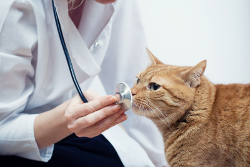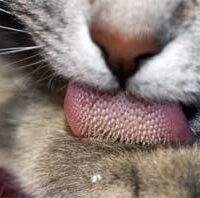Every cat owner dreads hearing that gagging sound. You know that any minute you’ll be hunched over scooping up a disgusting wad of fur matted with vomit (unless you have a Sphynx). Well, your cat doesn’t like them very much either. They can be a gross disruption to both your routines.
Aside from being a nuisance, hairballs have the potential of becoming a risk to your cat’s health. In some cases, they can cause bowel obstructions or get caught in the esophagus. While it’s not possible to rid your cat of hairballs completely, there are ways to help them occur less frequently.
What Exactly Are Hairballs and What Causes Them?
It may seem like your cat is something of a neat freak, always bathing and grooming. It turns out she has some very good reasons for this habit.
- Cats groom after a meal. In the wild they rely on removing all traces of a fresh kill to avoid altering other predators.
- They groom to keep themselves cool. Their body temperature remains cool through the evaporation process of grooming.
- Cats also groom to relieve stress, or simply to comfort themselves.
Those Sandpaper Tongues
All over the surface of her tongue, she has a collection of these little hook-shaped barbs called papillae. In the wild, or outdoors, they serve the purpose of scraping meat from the bones after a successful hunt. More commonly, when she’s seated on the back of your couch, they serve as her lint roller and brush.
During the grooming process, the papillae pick up loose fur, dirt, and debris. Your cat inevitably swallows it all. Most of it is digested and passed in stool, but some of it remains in the stomach. When a large collection of these particles accumulate in the stomach, you have a classic hairball. They are more frequent in cats with long coats but occur in all coated breeds.
Symptoms to Look Out For
We’re all familiar with the regurgitation of hairballs, but some other symptoms could develop as well. Always keep an eye out for the following:
- Constipation
- Diarrhea
- Loss of appetite
Please advise your veterinarian if any of these more troublesome symptoms arise. They could indicate intestinal blockage or even something more serious than hairballs.
Hairball Prevention
While there is no way to eliminate hairballs completely there are ways to assist your cat with managing them so they will occur less frequently.
- Brush your cat. She may seem like she has the grooming thing down pat but a little extra help goes a long way. When you brush her, you’re removing a lot of the loose fur, dirt and dander she would be ingesting and forming into a hairball. It’s also a bonding process. To her, it is considered social grooming and she will appreciate the time you spend grooming her as if you were a mother or a litter-mate.
- There are hairball lubricants and supplements available over-the-counter at pet specialty stores. These supplements allow for the dander and fur ingested during grooming to easily pass through the digestive tract instead of clotting up and forming a hairball. They come in chewables you can give as a treat or as a paste you squeeze onto your cat’s paw for her to lick off.
- If you have a cat that grooms excessively or compulsively, it could be that she is just bored. Bring home a new toy or try and peak her interest with other activities. Talk to your veterinarian if this behavior persists. With excessive grooming, there could be more at play than simple boredom. Sometimes there is an underlying health or mental issue that needs to be addressed.
Thanks for visiting www.catdandruffclinic.com, if you liked this article please like us using the side bar .



Comments are closed.